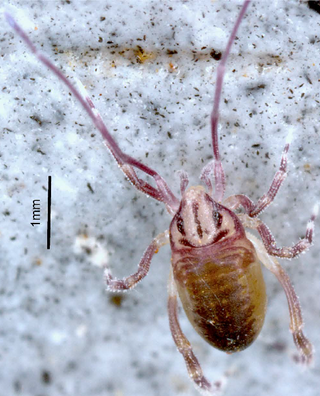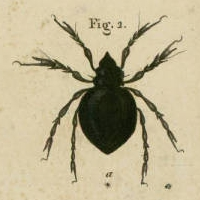
Trombicula, known as chiggers, red bugs, scrub-itch mites, or berry bugs, are small arachnids in the Trombiculidae family. In their larval stage, they attach to various animals, including humans, and feed on skin, often causing itching and trombiculosis. These relatives of ticks are nearly microscopic, measuring 0.4 mm (0.01 in) and have a chrome-orange hue. A common species of harvest mite in North America is Trombicula alfreddugesi.

Parasitiformes are a superorder of Arachnids, constituting one of the two major groups of mites, alongside Acariformes. Parasitiformes has, at times, been classified at the rank of order or suborder.

Opilioacaridae is the sole family of mites in the order Opilioacarida, made up of about 13 genera. The mites of this family are rare, large mites, and are widely considered primitive, as they retain six pairs of eyes, and abdominal segmentation. They have historically been considered separate from other mites belonging to Acariformes and Parasitiformes, but are now generally considered a subgroup of Parasitiformes based on molecular phylogenetics.

Mesostigmata is an order of mites belonging to the Parasitiformes. They are by far the largest group of Parasitiformes, with over 8,000 species in 130 families. Mesostigmata includes parasitic as well as free-living and predatory forms. They can be recognized by the single pair of spiracles positioned laterally on the body.

Lorryia formosa, commonly known as the yellow mite or the citrus yellow mite, is a species of acariform mite. They are in the subfamily Tydeinae of the family Tydeidae. Commonly found on the foliage of citrus trees around the world, Lorryia formosa also associates with a variety of other plant types. The life cycle includes six discrete stages of development, and the lifespan averages about 37 days. The females of the species use an asexual form of reproduction where the growth and development of embryos occurs without fertilization by a male, a process called thelytoky.
Antennoseius is a genus of mites in the family Ascidae. As of 2021, it comprised 59 species mostly in subgenera Antennoseius and Vitzthumia, as well as six species not assigned to a subgenus.

Rhinonyssidae is a family of mites in the order Mesostigmata. There are about 16 genera and at least 460 described species in Rhinonyssidae.
Charadrinyssus is a genus of mites in the family Rhinonyssidae. This genus has a single species, Charadrinyssus charadrius.
Larinyssus is a genus of mites in the family Rhinonyssidae. There are about five described species in Larinyssus.
Locustellonyssus is a genus of mites in the family Rhinonyssidae. There are at least two described species in Locustellonyssus.
Pipronyssus is a genus of mites in the family Rhinonyssidae. This genus has a single species, Pipronyssus manaci.

Ptilonyssus is a genus of mites in the family Rhinonyssidae. There are at least 230 described species in Ptilonyssus.
Rallinyssus is a genus of mites in the family Rhinonyssidae. There are about 12 described species in Rallinyssus.
Rhinonyssus is a genus of mites in the family Rhinonyssidae. There are more than 30 described species in Rhinonyssus.
Ruandanyssus is a genus of mites in the family Rhinonyssidae. There are at least three described species in Ruandanyssus.
Sternostoma is a genus of mites in the family Rhinonyssidae. There are more than 70 described species in Sternostoma.

Tinaminyssus is a genus of mites in the family Rhinonyssidae. There are more than 60 described species in Tinaminyssus.
Tyranninyssus is a genus of mites in the family Rhinonyssidae. There are at least four described species in Tyranninyssus.

Belba is a genus of mites belonging to family Damaeidae. The genus was established by Carl von Heyden in 1826. Notaspis corynopus was the type species. Species that are part of the genus can be found in Eurasia and North America.
Charletonia is a genus of mites belonging to the family Erythraeidae.








